warning Citroen C3 PICASSO RHD 2016 1.G Owner's Guide
[x] Cancel search | Manufacturer: CITROEN, Model Year: 2016, Model line: C3 PICASSO RHD, Model: Citroen C3 PICASSO RHD 2016 1.GPages: 296, PDF Size: 9.13 MB
Page 108 of 296
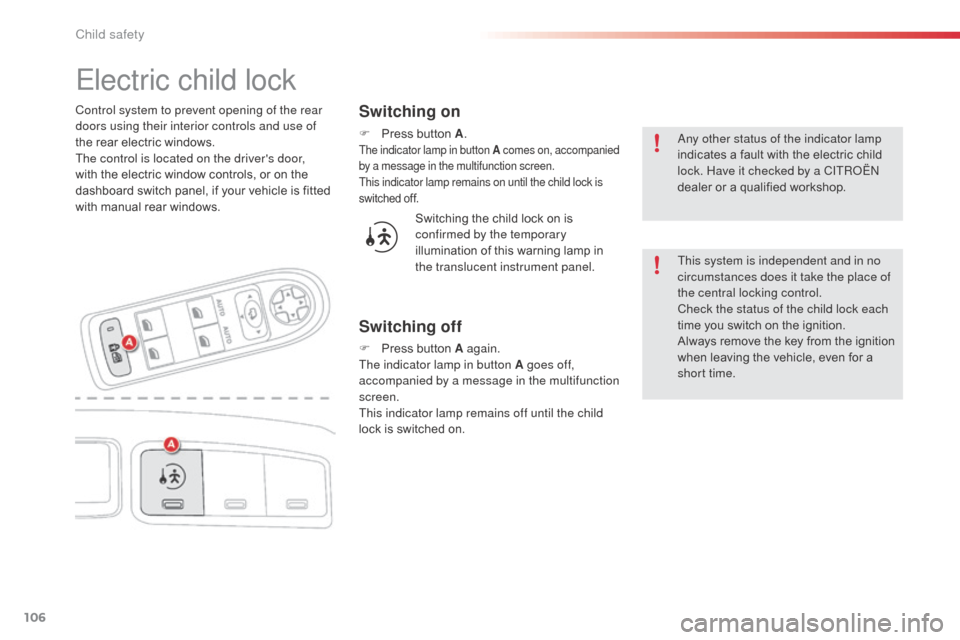
106
Electric child lock
Switching on
F Press button A.The indicator lamp in button A comes on, accompanied
by a message in the multifunction screen.
This indicator lamp remains on until the child lock is
switched off.
Switching off
F Press button A again.
The indicator lamp in button A goes off,
accompanied by a message in the multifunction
screen.
This indicator lamp remains off until the child
lock is switched on. Switching the child lock on is
confirmed by the temporary
illumination of this warning lamp in
the translucent instrument panel.
Any other status of the indicator lamp
indicates a fault with the electric child
lock. Have it checked by a CITROËN
dealer or a qualified workshop.
This system is independent and in no
circumstances does it take the place of
the central locking control.
Check the status of the child lock each
time you switch on the ignition.
Always remove the key from the ignition
when leaving the vehicle, even for a
short time.
Control system to prevent opening of the rear
doors using their interior controls and use of
the rear electric windows.
The control is located on the driver's door,
with the electric window controls, or on the
dashboard switch panel, if your vehicle is fitted
with manual rear windows.
Child safety
Page 109 of 296
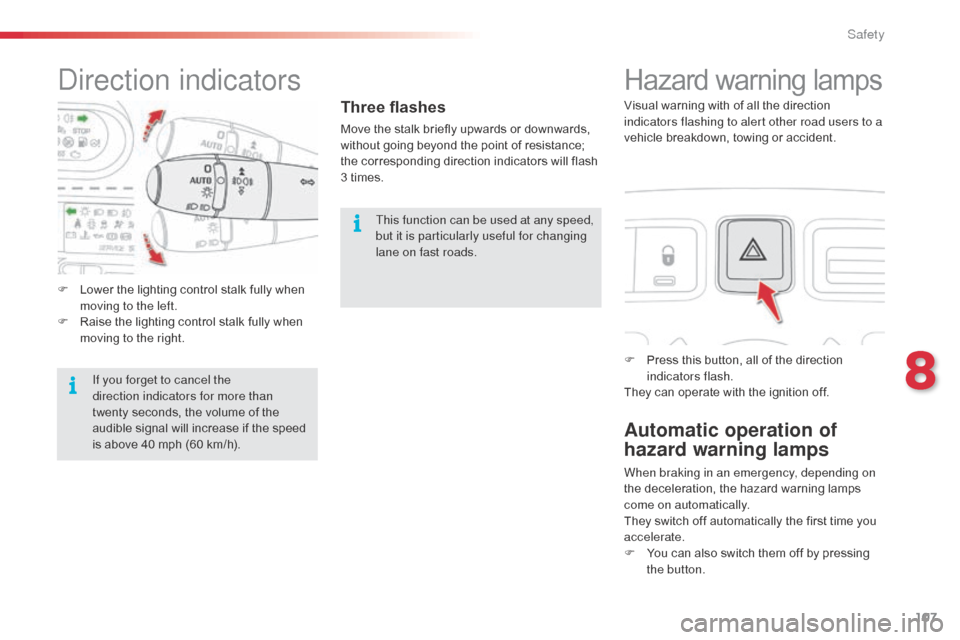
107
Direction indicatorsHazard warning lamps
F Press this button, all of the direction indicators flash.
They can operate with the ignition off.
Automatic operation of
hazard warning lamps
When braking in an emergency, depending on
the deceleration, the hazard warning lamps
come on automatically.
They switch off automatically the first time you
accelerate.
F
Y
ou can also switch them off by pressing
the button.
Three flashes
Move the stalk briefly upwards or downwards,
without going beyond the point of resistance;
the corresponding direction indicators will flash
3 times. Visual warning with of all the direction
indicators flashing to alert other road users to a
vehicle breakdown, towing or accident.
F
L
ower the lighting control stalk fully when
moving to the left.
F
R
aise the lighting control stalk fully when
moving to the right.
If you forget to cancel the
direction indicators for more than
twenty
seconds, the volume of the
audible signal will increase if the speed
is above 40 mph (60 km/h). This function can be used at any speed,
but it is particularly useful for changing
lane on fast roads.
8
Safety
Page 110 of 296
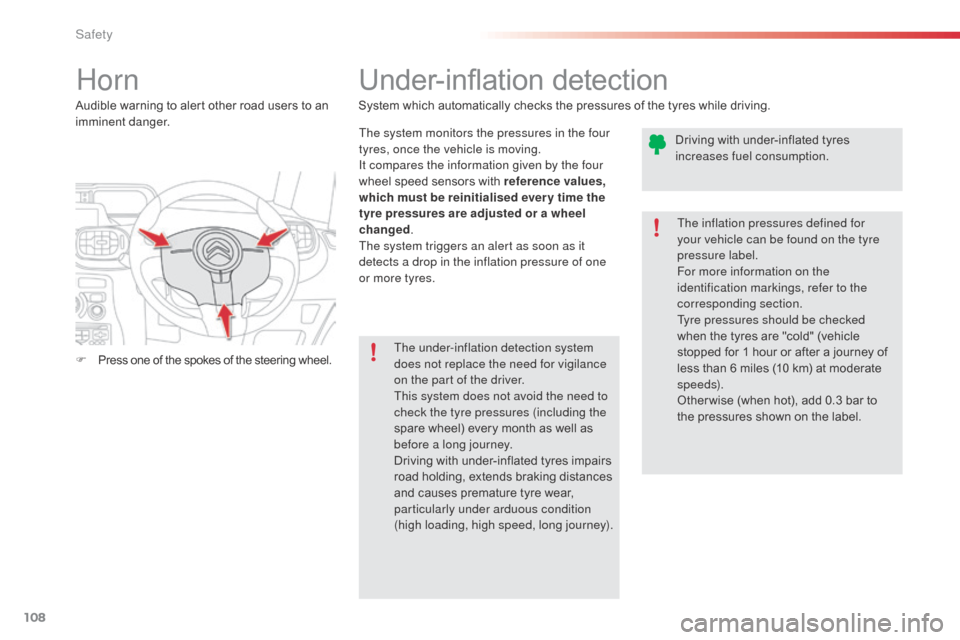
108
Horn
F Press one of the spokes of the steering wheel. Audible warning to alert other road users to an
imminent danger.
Under-inflation detection
System which automatically checks the pressures of the tyres while driving.The system monitors the pressures in the four
tyres, once the vehicle is moving.
It compares the information given by the four
wheel speed sensors with reference values,
which must be reinitialised ever y time the
tyre pressures are adjusted or a wheel
changed .
The system triggers an alert as soon as it
detects a drop in the inflation pressure of one
or more tyres.
The under-inflation detection system
does not replace the need for vigilance
on the part of the driver.
This system does not avoid the need to
check the tyre pressures (including the
spare wheel) every month as well as
before a long journey.
Driving with under-inflated tyres impairs
road holding, extends braking distances
and causes premature tyre wear,
particularly under arduous condition
(high loading, high speed, long journey). The inflation pressures defined for
your vehicle can be found on the tyre
pressure label.
For more information on the
identification markings, refer to the
corresponding section.
Tyre pressures should be checked
when the tyres are "cold" (vehicle
stopped for 1 hour or after a journey of
less than 6 miles (10 km) at moderate
speeds).
Other wise (when hot), add 0.3 bar to
the pressures shown on the label.
Driving with under-inflated tyres
increases fuel consumption.
Safety
Page 111 of 296

109
Under-inflation alert
This is given by fixed illumination of
this warning lamp, accompanied by
an audible signal and, depending on
equipment, the display of a message.
F
R
educe speed immediately, avoid
excessive steering movements and sudden
braking.
F
S
top the vehicle as soon as it is safe
to do so.
The loss of pressure detected does not
always cause visible bulging of the tyre.
Do not satisfy yourself with just a visual
check. The alert is maintained until the system
is reinitialised.
F
I n the event of a puncture, use the
temporary puncture repair kit or the spare
wheel (depending on equipment),
or
F
i
f you have a compressor, such as the one
in the temporary puncture repair kit, check
the pressures of the four tyres when cold,
or
F
i
f it is not possible to make this check
immediately, drive carefully at reduced
speed.
Reinitialisation
It is necessary to reinitialise the system every
time one or more tyre pressure is adjusted, and
after changing one or more wheels.
A label attached to the middle pillar, driver's
side, gives a reminder of this.
Before reinitialising the system, ensure
that the pressures of the four tyres are
correct for the use of the vehicle and in
line with the recommendations on the
tyre pressure label.
The under-inflation detection system
does not give a warning if a pressure is
incorrect at the time of reinitialisation.
8
Safety
Page 113 of 296
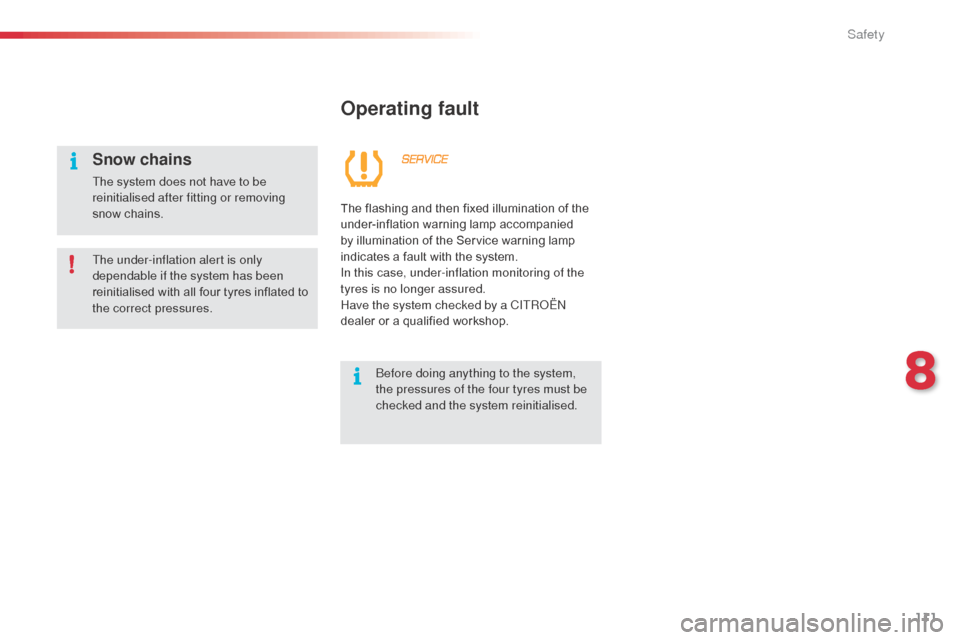
111
Operating fault
Before doing anything to the system,
the pressures of the four tyres must be
checked and the system reinitialised.
The flashing and then fixed illumination of the
under-inflation warning lamp accompanied
by illumination of the Service warning lamp
indicates a fault with the system.
In this case, under-inflation monitoring of the
tyres is no longer assured.
Have the system checked by a CITROËN
dealer or a qualified workshop.
Snow chains
The system does not have to be
reinitialised after fitting or removing
snow chains.
The under-inflation alert is only
dependable if the system has been
reinitialised with all four tyres inflated to
the correct pressures.
8
Safety
Page 114 of 296
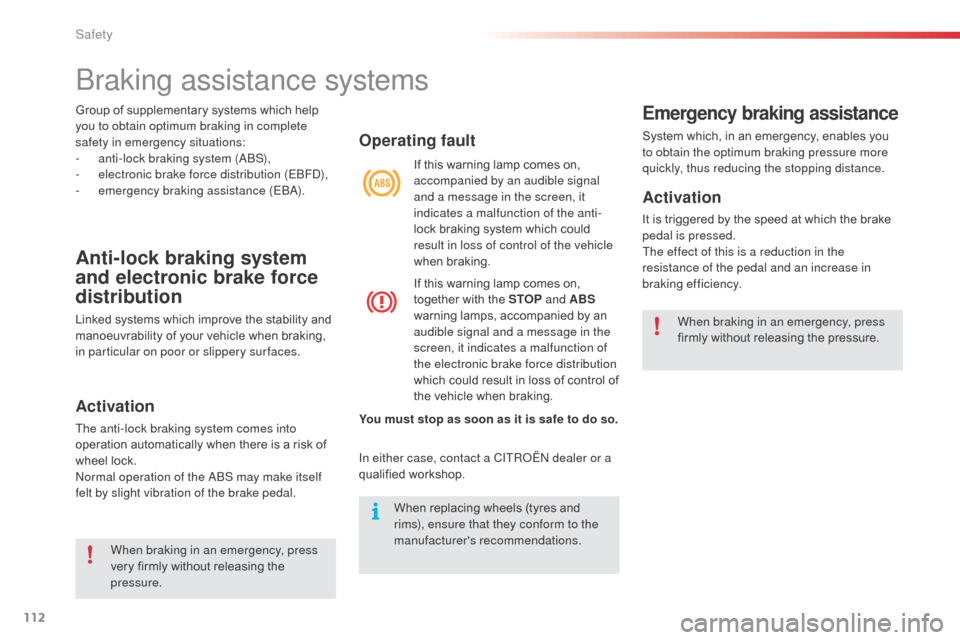
112
Braking assistance systems
Anti-lock braking system
and electronic brake force
distribution
Linked systems which improve the stability and
manoeuvrability of your vehicle when braking,
in particular on poor or slippery sur faces.
Activation
The anti-lock braking system comes into
operation automatically when there is a risk of
wheel lock.
Normal operation of the ABS may make itself
felt by slight vibration of the brake pedal.When braking in an emergency, press
very firmly without releasing the
pressure.
Group of supplementary systems which help
you to obtain optimum braking in complete
safety in emergency situations:
-
a
nti-lock braking system (ABS),
-
e
lectronic brake force distribution (EBFD),
-
em
ergency braking assistance (EBA).
Operating fault
If this warning lamp comes on,
accompanied by an audible signal
and a message in the screen, it
indicates a malfunction of the anti-
lock braking system which could
result in loss of control of the vehicle
when braking.
If this warning lamp comes on,
together with the STOP
and ABS
warning lamps, accompanied by an
audible signal and a message in the
screen, it indicates a malfunction of
the electronic brake force distribution
which could result in loss of control of
the vehicle when braking.
Emergency braking assistance
System which, in an emergency, enables you
to obtain the optimum braking pressure more
quickly, thus reducing the stopping distance.
Activation
It is triggered by the speed at which the brake
pedal is pressed.
The effect of this is a reduction in the
resistance of the pedal and an increase in
braking efficiency.
In either case, contact a CITROËN dealer or a
qualified workshop. When braking in an emergency, press
firmly without releasing the pressure.
When replacing wheels (tyres and
rims), ensure that they conform to the
manufacturer's recommendations.
You must stop as soon as it is safe to do so.
Safety
Page 115 of 296
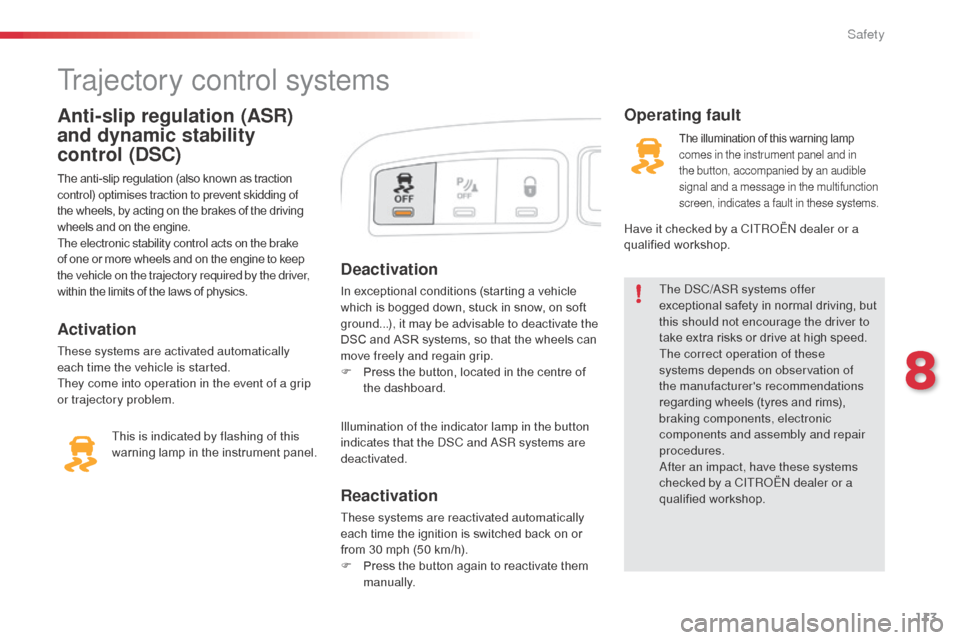
113
Deactivation
In exceptional conditions (starting a vehicle
which is bogged down, stuck in snow, on soft
ground...), it may be advisable to deactivate the
DSC and ASR systems, so that the wheels can
move freely and regain grip.
F
P
ress the button, located in the centre of
the dashboard.
Illumination of the indicator lamp in the button
indicates that the DSC and ASR systems are
deactivated.
Reactivation
These systems are reactivated automatically
each time the ignition is switched back on or
from 30 mph (50 km/h).
F
P
ress the button again to reactivate them
manually.
Operating fault
The illumination of this warning lamp
comes in the instrument panel and in
the button, accompanied by an audible
signal and a message in the multifunction
screen, indicates a fault in these systems.
Trajectory control systems
The anti-slip regulation (also known as traction
control) optimises traction to prevent skidding of
the wheels, by acting on the brakes of the driving
wheels and on the engine.
The electronic stability control acts on the brake
of one or more wheels and on the engine to keep
the vehicle on the trajectory required by the driver,
within the limits of the laws of physics.
Anti-slip regulation (ASR)
and dynamic stability
control (DSC)
This is indicated by flashing of this
warning lamp in the instrument panel.
Activation
These systems are activated automatically
each time the vehicle is started.
They come into operation in the event of a grip
or trajectory problem. The DSC/ASR systems offer
exceptional safety in normal driving, but
this should not encourage the driver to
take extra risks or drive at high speed.
The correct operation of these
systems depends on observation of
the manufacturer's recommendations
regarding wheels (tyres and rims),
braking components, electronic
components and assembly and repair
procedures.
After an impact, have these systems
checked by a CITROËN dealer or a
qualified workshop.
Have it checked by a CITROËN dealer or a
qualified workshop.
8
Safety
Page 116 of 296
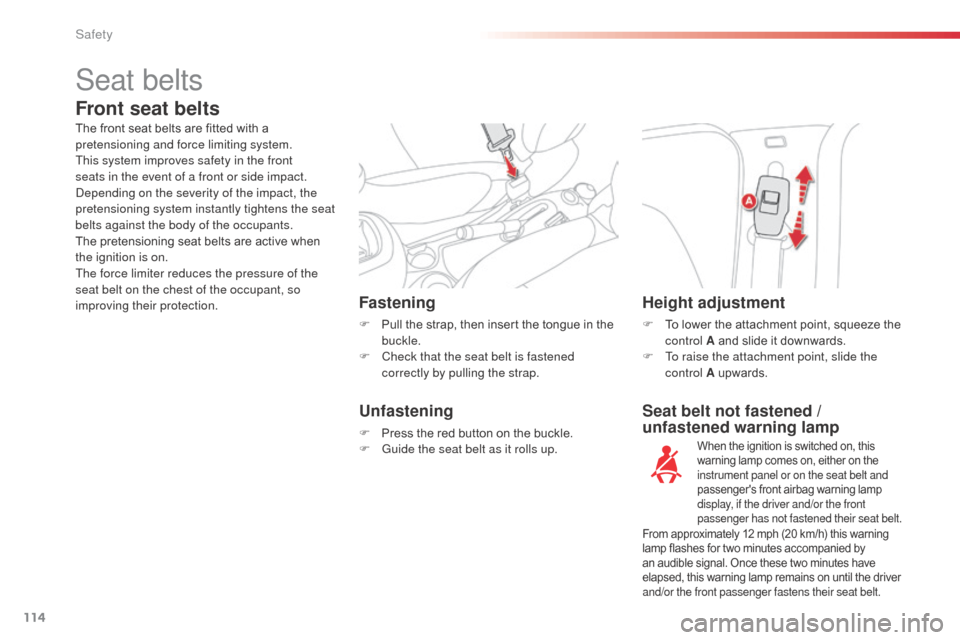
114
Seat belt not fastened /
unfastened warning lamp
Fastening
F Pull the strap, then insert the tongue in the
buckle.
F
C
heck that the seat belt is fastened
correctly by pulling the strap.
Height adjustment
F To lower the attachment point, squeeze the control A and slide it downwards.
F
T
o raise the attachment point, slide the
control A upwards.
When the ignition is switched on, this
warning lamp comes on, either on the
instrument panel or on the seat belt and
passenger's front airbag warning lamp
display, if the driver and/or the front
passenger has not fastened their seat belt.
Unfastening
F Press the red button on the buckle.
F G uide the seat belt as it rolls up.
Seat belts
Front seat belts
The front seat belts are fitted with a
pretensioning and force limiting system.
This system improves safety in the front
seats in the event of a front or side impact.
Depending on the severity of the impact, the
pretensioning system instantly tightens the seat
belts against the body of the occupants.
The pretensioning seat belts are active when
the ignition is on.
The force limiter reduces the pressure of the
seat belt on the chest of the occupant, so
improving their protection.
From approximately 12 mph (20 km/h) this warning
lamp flashes for two minutes accompanied by
an audible signal. Once these two minutes have
elapsed, this warning lamp remains on until the driver
and/or the front passenger fastens their seat belt.
Safety
Page 117 of 296
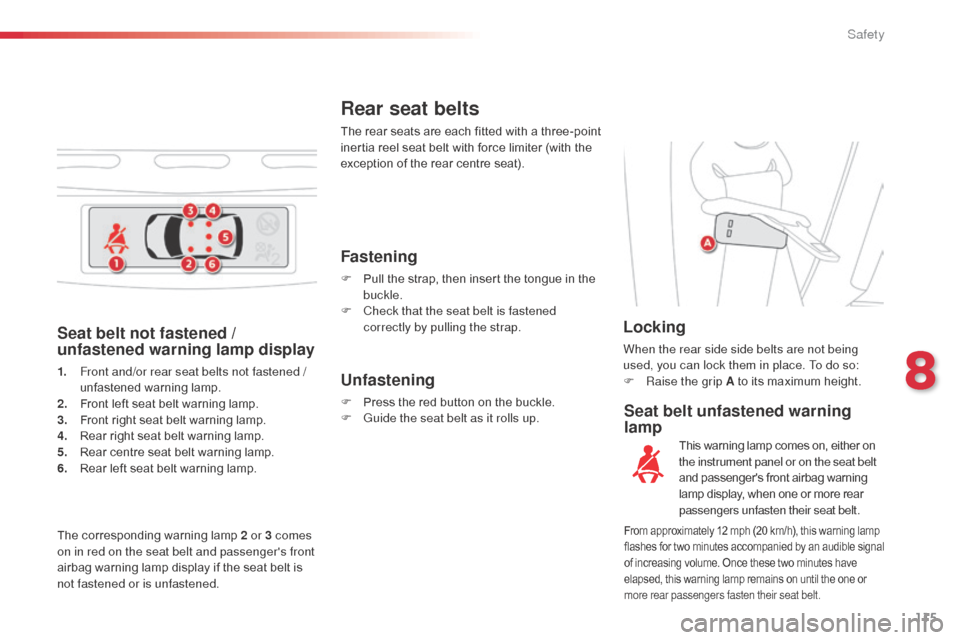
115
Seat belt not fastened /
unfastened warning lamp display
1. Front and/or rear seat belts not fastened / unfastened warning lamp.
2.
F
ront left seat belt warning lamp.
3.
F
ront right seat belt warning lamp.
4.
R
ear right seat belt warning lamp.
5.
R
ear centre seat belt warning lamp.
6.
R
ear left seat belt warning lamp.
Rear seat belts
The rear seats are each fitted with a three-point
inertia reel seat belt with force limiter (with the
exception of the rear centre seat).
Locking
When the rear side side belts are not being
used, you can lock them in place. To do so:
F
Ra
ise the grip A to its maximum height.
Fastening
F Pull the strap, then insert the tongue in the buckle.
F
C
heck that the seat belt is fastened
correctly by pulling the strap.
Unfastening
F Press the red button on the buckle.
F G uide the seat belt as it rolls up.
The corresponding warning lamp 2 or 3 comes
on in red on the seat belt and passenger's front
airbag warning lamp display if the seat belt is
not fastened or is unfastened.Seat belt unfastened warning
lamp
This warning lamp comes on, either on
the instrument panel or on the seat belt
and passenger's front airbag warning
lamp display, when one or more rear
passengers unfasten their seat belt.
From approximately 12 mph (20 km/h), this warning lamp
flashes for two minutes accompanied by an audible signal
of increasing volume. Once these two minutes have
elapsed, this warning lamp remains on until the one or
more rear passengers fasten their seat belt.
8
Safety
Page 118 of 296
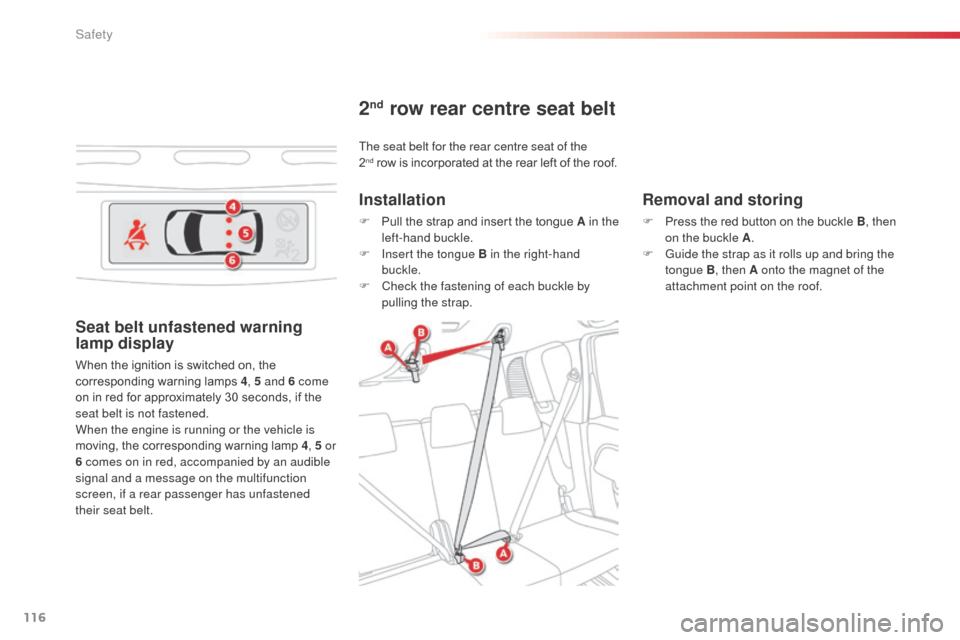
116
2nd row rear centre seat belt
Removal and storing
F Press the red button on the buckle B, then on the buckle A .
F
G
uide the strap as it rolls up and bring the
tongue B , then A
onto the magnet of the
attachment point on the roof.
Installation
F Pull the strap and insert the tongue A in the left-hand buckle.
F
I
nsert the tongue B in the right-hand
buckle.
F
C
heck the fastening of each buckle by
pulling the strap.
The seat belt for the rear centre seat of the
2
nd row is incorporated at the rear left of the roof.
Seat belt unfastened warning
lamp display
When the ignition is switched on, the
corresponding warning lamps
4, 5 and 6 come
on in red for approximately 30 seconds, if the
seat belt is not fastened.
When the engine is running or the vehicle is
moving, the corresponding warning lamp 4, 5 or
6 comes on in red, accompanied by an audible
signal and a message on the multifunction
screen, if a rear passenger has unfastened
their seat belt.
Safety